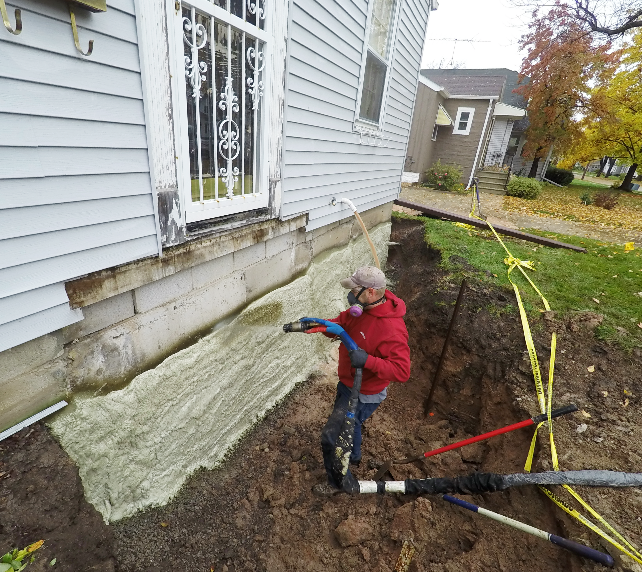How Does Expanding Foam Concrete Work
May 16, 2024
How Does Expanding Foam Concrete Work
Welcome to the fascinating world of expanding foam concrete! Have you ever wondered how this innovative material works its magic in construction projects? In this blog post, we will delve into the science behind expanding foam concrete, explore its benefits, uncover its diverse applications, and compare it with traditional concrete methods. Get ready to expand your knowledge on expanding foam concrete!
How Does Expanding Foam Concrete Work
Expanding foam concrete operates on a unique principle that sets it apart from traditional concrete. When mixed, this material contains special additives that create tiny air bubbles throughout the mixture.
As the foam expands and cures, these bubbles distribute evenly, resulting in a lightweight yet strong final product. This expansion process enhances the concrete’s thermal and acoustic insulation properties.
The foam also allows for better flowability during installation, enabling it to fill even the tiniest gaps and crevices within a structure. This feature makes expanding foam concrete an excellent choice for void filling applications.
Additionally, its ability to self-level ensures a smooth finish without the need for extensive manual labor or additional compaction equipment. The result is a durable and uniform surface suitable for various construction projects.
Understanding how expanding foam concrete works sheds light on why it has become increasingly popular in modern construction practices due to its versatility, strength, and efficiency.
Understanding the Science Behind Expanding Foam
Expanding foam concrete might sound like a magical material, but its effectiveness is rooted in science. When the two main components, resin and hardener, are mixed together, a chemical reaction occurs. This reaction releases gas bubbles that cause the mixture to expand and solidify.
The expansion of the foam creates a lightweight yet durable material with excellent thermal insulation properties. The closed-cell structure of the foam also contributes to its strength and ability to withstand pressure. Additionally, the expanding foam fills voids and gaps when poured into place, ensuring a tight seal.
One key aspect of expanding foam concrete is its versatility in various applications. Whether used for filling cavities or as an alternative to traditional concrete in construction projects, expanding foam offers unique benefits due to its lightweight nature and insulation properties.
The science behind expanding foam concrete makes it an attractive choice for many builders and contractors looking for efficient solutions that provide both structural integrity and energy efficiency. Understanding how this innovative material works can help unleash its full potential in diverse construction projects.
In essence, mastering the science behind expanding foam concrete opens up endless possibilities for creating sustainable structures that are not only strong but also energy-efficient in today’s evolving construction industry landscape.
Benefits of Expanding Foam Concrete
Expanding foam concrete offers a range of benefits that make it an attractive choice for various construction projects. Its lightweight nature makes it easier to handle and transport compared to traditional concrete, reducing labor and transportation costs. Additionally, the expanding properties of foam concrete allow it to fill voids efficiently, creating a seamless and strong foundation.
Moreover, the insulation properties of expanding foam concrete help regulate temperature variations within structures, leading to energy savings in heating and cooling expenses. This thermal efficiency also contributes to improved indoor comfort levels for occupants throughout the year.
Another key advantage is the ability of expanding foam concrete to reduce noise transmission through walls and floors, enhancing acoustic performance in buildings. This feature is particularly beneficial in residential areas or commercial spaces where soundproofing is crucial for occupant satisfaction.
Furthermore, the versatility of expanding foam concrete allows for customization based on specific project requirements. It can be easily molded into various shapes and sizes while maintaining its structural integrity, offering flexibility in design possibilities for architects and engineers.
In conclusion (as per instructions), these benefits collectively position expanding foam concrete as a cost-effective and sustainable alternative to conventional construction materials with added advantages in terms of durability, efficiency, and design adaptability.
Applications of Expanding Foam Concrete
Expanding foam concrete has a wide range of applications across various industries due to its unique properties and versatility. One common use is in the construction of lightweight structures, such as prefabricated panels and insulation for buildings. The lightweight nature of foam concrete makes it ideal for reducing structural load while maintaining strength.
In addition to building construction, expanding foam concrete is also utilized in infrastructure projects like road repairs and tunnel linings. Its ability to fill voids and stabilize soil make it an excellent choice for ground improvement applications. The expansive nature of foam concrete allows it to conform to irregular surfaces, making it perfect for filling cavities or voids in hard-to-reach areas.
Moreover, expanding foam concrete finds its place in geotechnical engineering for slope stabilization and erosion control. The material’s high flowability enables it to easily reach confined spaces, providing effective reinforcement against soil movement. Furthermore, the insulating properties of foam concrete make it suitable for thermal protection applications in cold storage facilities or cryogenic tanks.
Another interesting application lies in underwater constructions where traditional methods may not be feasible. Expanding foam concrete can be pumped underwater to create foundations or repair marine structures efficiently. Its rapid curing time ensures quick project completion even under challenging conditions like water immersion.
The diverse applications of expanding foam concrete continue to expand as more industries recognize its benefits and innovative uses across different sectors globally.
Comparison with Traditional Concrete Methods
Expanding foam concrete offers a revolutionary approach to traditional concrete methods. Its lightweight nature, high insulation properties, and ease of application make it a versatile choice for various construction projects. By understanding the science behind expanding foam and exploring its benefits and applications, it becomes evident that this innovative material is transforming the way we think about building materials.
When compared to traditional concrete methods, expanding foam concrete stands out for its efficiency in both time and labor. Traditional concrete requires extensive formwork, curing time, and heavy machinery for installation. In contrast, expanding foam can be easily sprayed into place, reducing overall construction time significantly. Additionally, its superior insulation properties provide energy savings over time – something traditional concrete cannot offer.
Expanding foam concrete represents a new era in construction technology, offering sustainable solutions with enhanced performance metrics compared to conventional materials. As advancements continue in this field, we can expect further innovations that will shape the future of the construction industry. Contact Rescon Basement Solutions today for help with your basement!

